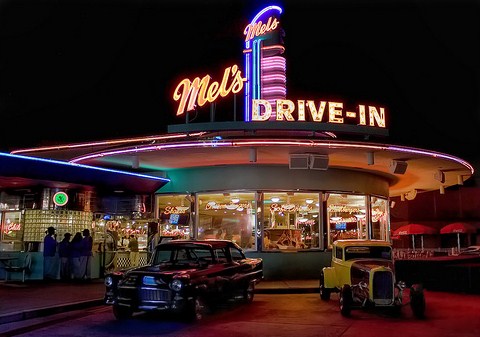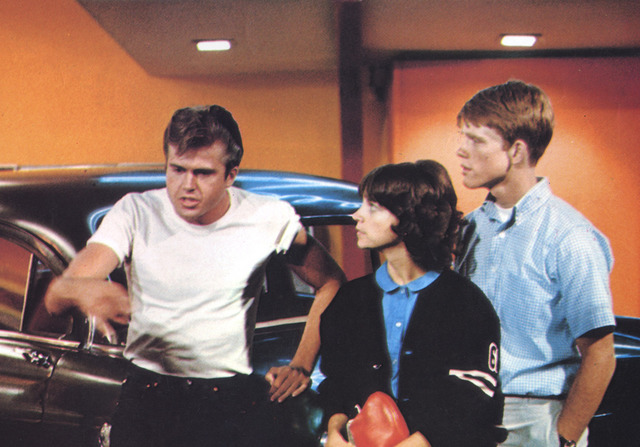This, dear readers, is the beginning of a new frontier in my blogging career. OK, “frontier” is a little over-dramatic, but there you go. I have considered for a while doing a series of blogs every week to celebrate the best that cinema has given us, what we may call “Classic Movies”. They can be of any country, of any year and any length – although what they all share is a compelling cinematic language. They may be culturally significant or otherwise, popular or little-known. Over the series I will question what it means to be a “Classic Movie”, and what is in store for the future. It will bring me to mainstream and cult-ish directors, a range of different styles and stories. The first film in this series is American Graffiti (1973).
Ah, the 1970s. A decade of exploitation and rock music. It was also the decade in which George Lucas actually directed some good films. There’s the obvious candidate, Star Wars (1977), which pretty much ensured his future, as well as inspiring a whole generation of lightsabre-wielding enthusiasts. Then there’s the lesser-known but distinctly Orwellian THX 1138 (1971) , another sci-fi film, which was (like Star Wars) restored lavishly but impassively in 2004.
Between these two came American Graffiti, a film which is entirely different to anything Lucas has directed. Set in 1962 California, it revolves around a group of high school graduates who go cruising in their cars in the city for one last night before they go off to college. Partly based on Lucas’ own “cruising” experiences, the film is a heavily nostalgic experience, featuring classic vehicles, old-style haircuts and a soundtrack of rock and roll hits. From the opening scene, the viewer is thrown back to the decade epitomised by youth culture and social revolution. The teenagers discuss the decline of rock music, relationships and leaving town, whilst racing each other in old Chevrolets, and the film’s potent tagline is: “Where were you in ’62?”

Misunderstood by Universal prior to its release, Lucas reluctantly accepted removing certain scenes that the executives had suggested. Contrary to the studio’s expectations, American Graffiti ultimately went on to become a major success, and holds out to this day as one of the most brilliant portrayals of youth in cinema.
The studio still had their reservations before production had even begun. A group of unknown young actors would make up the cast and Lucas himself was still in the background as a director. After getting Francis Ford Coppola on board, however, the film was greenlit. The director’s keen eye for casting is immediately noticeable; despite his lack of words during their interviews, all of the film’s young leads are utterly convincing. Richard Dreyfuss searches aimlessly for the dream woman he glimpsed in a white Thunderbird, whilst philosophically contemplating whether or not he should leave town. Paul Le Mat cruises around and is angered at the entrance of a tenacious young girl into his car. Ron Howard attempts to sort out his relationship issues, while Charles Martin Smith tries in vain to avoid embarrassment in front of Candy Clark. As several stories are told simultaneously, the film is never dull and its technique is intriguing. Lucas chose to film every scene at night, and more in a documentary style. Much is improvised, including several key scenes. This gives the actors free reign over their characters and makes the whole thing incredibly fresh and believable, as well as extremely funny.

Pre-released music is used throughout and is treated almost like a sound effect in itself. The filmmakers do an extremely good job in arranging the songs when considering they were on a low budget (which somewhat explains the strange lack of Elvis from the soundtrack). In one of the best-executed scenes in the film, Dreyfuss enters a radio station and converses with the real-life gravelly-voiced and mysterious disc jockey Wolfman Jack. After reading a script of the scene whilst on the air, Jack immediately agreed to star in the film, saying it was one of the most emotional things he had ever read.
And emotion is what really ties American Graffiti together. These four teenage friends are burdened by the petrifying prospect of maturity and adulthood, and each goes through their own personal journey. The film can be related to by practically anyone on the planet – the new experience of leaving your home town, your surroundings and your friends, perhaps permanently, is an emotional ride and often a very difficult procedure. Lucas perfectly captures the joys and sorrows of youth in a 1960s Californian setting, and the film is a living tribute to that illustrious decade of new ideas and culture.

It has and will continue to suffer inevitable comparisons to other high-school-film offerings such as Grease, which is a terrible shame. While Grease is glossed over with cheese, American Graffiti is far more sensitive, honest and homegrown. Its cast is well-chosen, its directorial execution impressive; a true achievement.
N.B. George Lucas’ American Graffiti was added in 1995 to the National Film Registry for “culturally, historically or aesthetically significant films”.